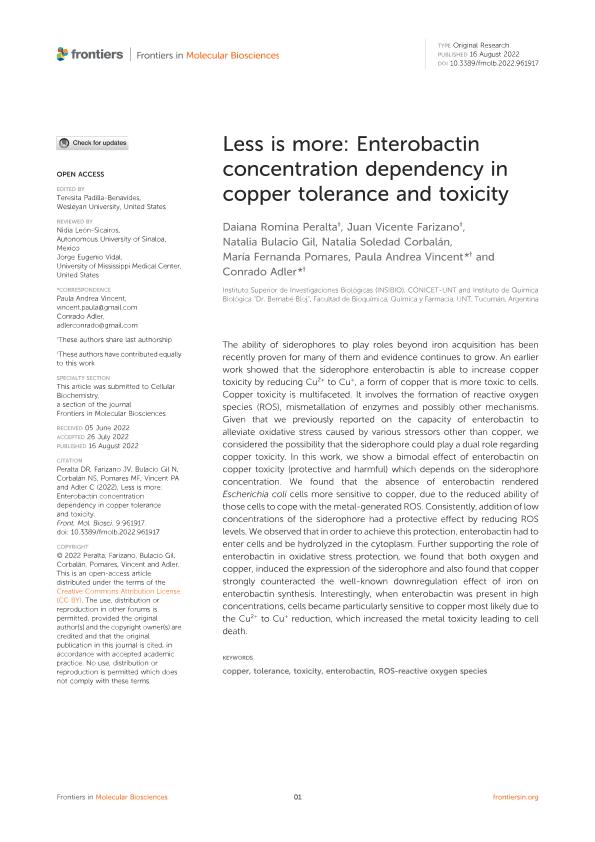Artículo
Less is more: Enterobactin concentration dependency in copper tolerance and toxicity
Peralta, Daiana Romina ; Farizano, Juan Vicente
; Farizano, Juan Vicente ; Bulacio Gil, Natalia María
; Bulacio Gil, Natalia María ; Corbalan, Natalia Soledad
; Corbalan, Natalia Soledad ; Pomares, Maria Fernanda
; Pomares, Maria Fernanda ; Vincent, Paula Andrea
; Vincent, Paula Andrea ; Adler, Conrado
; Adler, Conrado
 ; Farizano, Juan Vicente
; Farizano, Juan Vicente ; Bulacio Gil, Natalia María
; Bulacio Gil, Natalia María ; Corbalan, Natalia Soledad
; Corbalan, Natalia Soledad ; Pomares, Maria Fernanda
; Pomares, Maria Fernanda ; Vincent, Paula Andrea
; Vincent, Paula Andrea ; Adler, Conrado
; Adler, Conrado
Fecha de publicación:
08/2022
Editorial:
Frontiers Media
Revista:
Frontiers in Molecular Biosciences
e-ISSN:
2296-889X
Idioma:
Inglés
Tipo de recurso:
Artículo publicado
Clasificación temática:
Resumen
The ability of siderophores to play roles beyond iron acquisition has been recently proven for many of them and evidence continues to grow. An earlier work showed that the siderophore enterobactin is able to increase copper toxicity by reducing Cu2+ to Cu+, a form of copper that is more toxic to cells. Copper toxicity is multifaceted. It involves the formation of reactive oxygen species (ROS), mismetallation of enzymes and possibly other mechanisms. Given that we previously reported on the capacity of enterobactin to alleviate oxidative stress caused by various stressors other than copper, we considered the possibility that the siderophore could play a dual role regarding copper toxicity. In this work, we show a bimodal effect of enterobactin on copper toxicity (protective and harmful) which depends on the siderophore concentration. We found that the absence of enterobactin rendered Escherichia coli cells more sensitive to copper, due to the reduced ability of those cells to cope with the metal-generated ROS. Consistently, addition of low concentrations of the siderophore had a protective effect by reducing ROS levels. We observed that in order to achieve this protection, enterobactin had to enter cells and be hydrolyzed in the cytoplasm. Further supporting the role of enterobactin in oxidative stress protection, we found that both oxygen and copper, induced the expression of the siderophore and also found that copper strongly counteracted the well-known downregulation effect of iron on enterobactin synthesis. Interestingly, when enterobactin was present in high concentrations, cells became particularly sensitive to copper most likely due to the Cu2+ to Cu+ reduction, which increased the metal toxicity leading to cell death.
Palabras clave:
COOPER
,
TOLERANCE
,
TOXICITY
,
ENTEROBACTIN
,
ROS-REACTIVE OXYGEN SPECIES
Archivos asociados
Licencia
Identificadores
Colecciones
Articulos(CCT - SALTA-JUJUY)
Articulos de CTRO.CIENTIFICO TECNOL.CONICET - SALTA-JUJUY
Articulos de CTRO.CIENTIFICO TECNOL.CONICET - SALTA-JUJUY
Articulos(INBIONATEC)
Articulos de INSTITUTO DE BIONANOTECNOLOGIA DEL NOA
Articulos de INSTITUTO DE BIONANOTECNOLOGIA DEL NOA
Articulos(INSIBIO)
Articulos de INST.SUP.DE INVEST.BIOLOGICAS
Articulos de INST.SUP.DE INVEST.BIOLOGICAS
Citación
Peralta, Daiana Romina; Farizano, Juan Vicente; Bulacio Gil, Natalia María; Corbalan, Natalia Soledad; Pomares, Maria Fernanda; et al.; Less is more: Enterobactin concentration dependency in copper tolerance and toxicity; Frontiers Media; Frontiers in Molecular Biosciences; 9; 961917; 8-2022; 1-12
Compartir
Altmétricas



